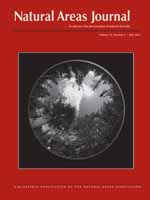Species inventory is considered an important component of natural resource management in National Park System units. We trapped small mammals in forested patches in the Grand Sable Dunes, Pictured Rocks National Lakeshore, Michigan, during 2007 and 2009 to inventory species occurrences and test predictions of island biogeography theory in a terrestrial landscape. We captured 538 individuals representing nine small mammal species. Fewer species were present in isolated patches than those closer to the mainland or another patch (F1, 11 = 5.752, P = 0.035), as predicted. Contrary to predictions, there was no relationship between species richness and patch area, proportion of patch edge, or other isolation metrics. We documented range expansion of a southern species, the white-footed mouse (Peromyscus leucopus Rafinesque), into the Grand Sable Dunes. White-footed mice were more likely to be captured in less isolated patches (Omnibus χ21 = 9.684, Nagelkerke R2 = 0.605, P = 0.002). Our results provide the first small mammal inventory for the Grand Sable Dunes and will serve as a baseline for future monitoring of small mammal species in this perched-dune system.
How to translate text using browser tools
1 July 2012
Effects of Forest Patch Characteristics on Small Mammal Species Composition, Grand Sable Dunes, Michigan
Sarah Lou Malick,
John G. Bruggink,
Jerrold L. Belant
ACCESS THE FULL ARTICLE

Natural Areas Journal
Vol. 32 • No. 3
July 2012
Vol. 32 • No. 3
July 2012
island biogeography
Michigan
small mammals
species richness




